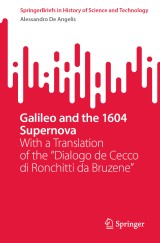Details

Galileo and the 1604 Supernova
With a Translation of the "Dialogo de Cecco di Ronchitti da Bruzene"SpringerBriefs in History of Science and Technology
|
48,14 € |
|
| Verlag: | Springer |
| Format: | |
| Veröffentl.: | 20.07.2024 |
| ISBN/EAN: | 9783031594861 |
| Sprache: | englisch |
Dieses eBook enthält ein Wasserzeichen.
Beschreibungen
<p>This book is about the 1604 supernova and presents the translation of key documents discussing this astronomical event in Italy. Only seven Galactic supernovae visible to the naked eye are documented, with the 1604 event, the last in history, profoundly impacting astronomy, cosmology, and culture in general. The 1604 supernova challenged the prevailing belief in the unchanging nature of stars. Astronomers like Galileo and Kepler, alongside counterparts from Arab, Chinese, and Korean backgrounds, collaborated to explain its origin, analyzing astronomical and astrological signals five years before the invention of the telescope. Galileo, approached for interpretation while teaching in Padua, cautiously expressed his views in three unpublished lectures, a pseudonymous treatise written in Paduan dialect, and a poem immediately withdrawn, sparking a dispute with Aristotelian scholars in Italy. The 1604 supernova, a pivotal historical event, spurred collaborative efforts and debates, reshaping perceptions of the cosmos. This debate dominated science from 1604 to 1606, preceding Kepler's treatise {\em De Stella Nova}. Remnants of the explosion of the supernova, called today Kepler’s supernova, are still visible and are the subject of studies by modern observatories and discussions in the astrophysical community.</p><p></p>
<p>Supernovae.- The 1604 Supernova.- Galilei against the Aristotelics.- Past, Present, Future. </p><br>
<p>Alessandro De Angelis is a high-energy physicist and an astrophysicist. A professor at the Universities of Padua and Lisbon and the scientific counselor at the Delegation of Italy to the International Organizations in Paris, he is the principal investigator for the proposed space mission ASTROGAM and, for many years, has been the director of research at the Italian National Institute for Nuclear Physics, and the scientific coordinator and the chairman of the board managing the MAGIC gamma-ray telescopes on the Canary Island of La Palma. His main research interest is in fundamental physics, especially astrophysics and elementary particle physics in accelerators. He graduated from Padua, was employed at CERN for seven years in the 1990s, ending as a staff member, and was later among the founding members of NASA's Fermi gamma-ray telescope project. His original scientific contributions have mostly been related to quantum chromodynamics, artificial neural networks, and the study of thecosmological propagation of photons. He has taught astro-particle physics in Italy and Portugal and has been a visiting professor at the Universities of Buenos Aires, Tokyo, Paris VI, and at the Max-Planck Institute in Munich. He has been the author of books, scientific publications in journals including Science and Nature, general interest articles, and essays in the history and philosophy of science.</p><p></p>
<p>This book is about the 1604 supernova and presents the translation of key documents discussing this astronomical event in Italy. Only seven Galactic supernovae visible to the naked eye are documented, with the 1604 event, the last in history, profoundly impacting astronomy, cosmology, and culture in general. The 1604 supernova challenged the prevailing belief in the unchanging nature of stars. Astronomers like Galileo and Kepler, alongside counterparts from Arab, Chinese, and Korean backgrounds, collaborated to explain its origin, analyzing astronomical and astrological signals five years before the invention of the telescope. Galileo, approached for interpretation while teaching in Padua, cautiously expressed his views in three unpublished lectures, a pseudonymous treatise written in Paduan dialect, and a poem immediately withdrawn, sparking a dispute with Aristotelian scholars in Italy. The 1604 supernova, a pivotal historical event, spurred collaborative efforts and debates, reshaping perceptions of the cosmos. This debate dominated science from 1604 to 1606, preceding Kepler's treatise {\em De Stella Nova}. Remnants of the explosion of the supernova, called today Kepler’s supernova, are still visible and are the subject of studies by modern observatories and discussions in the astrophysical community.</p>
Offers a unique translation on the fundamental documents published in 1604 Provides for the first time a Dialog, probably by Galileo, which precedes his most famous dialogs Presents the translation of key documents discussing the 1604 supernova astronomical event in Italy

















